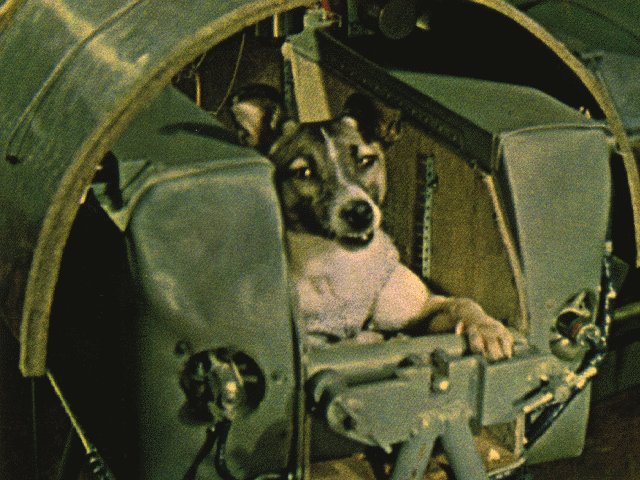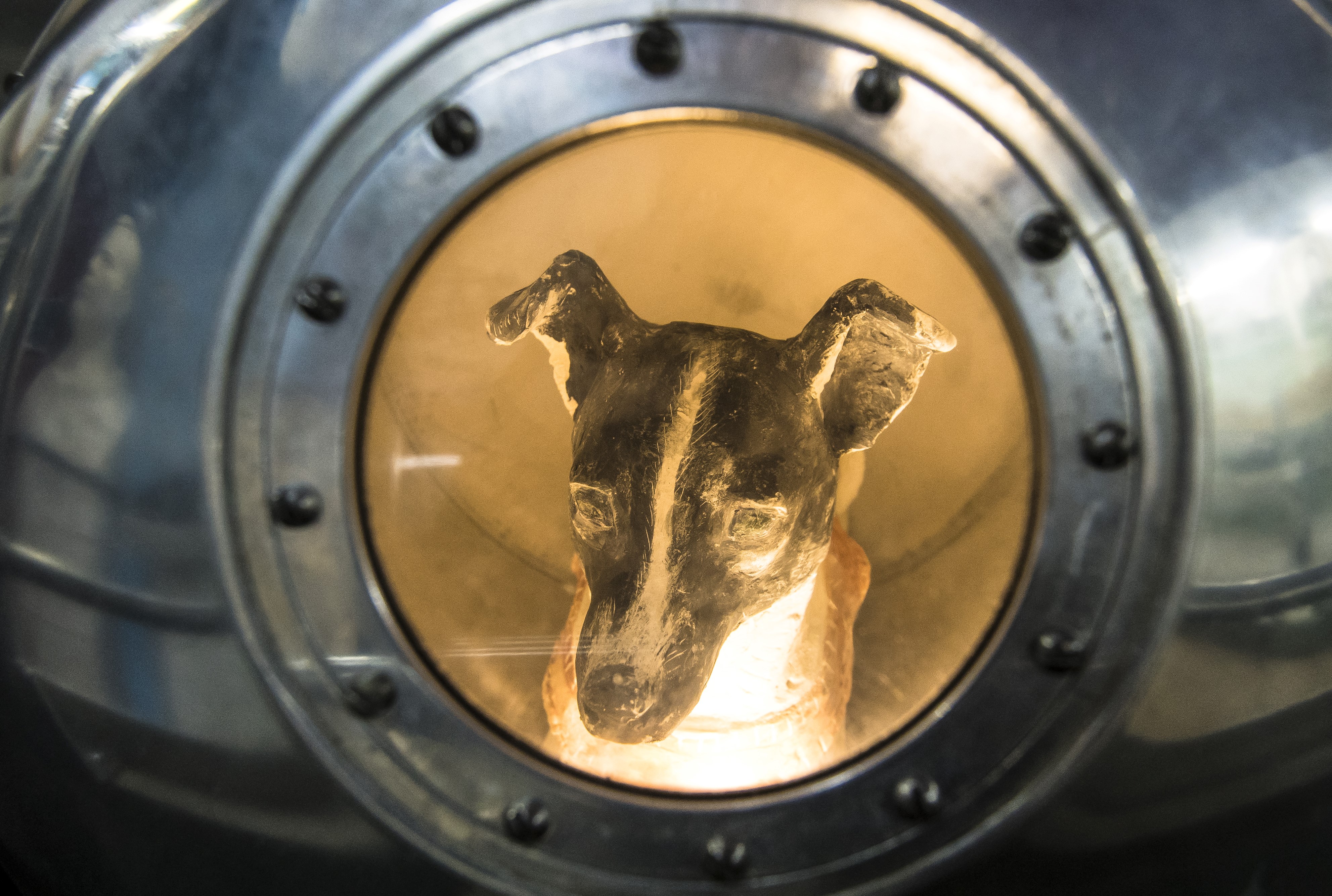Laika the space dog: First living creature in orbit
Laika, a Moscow street dog, became the first creature to orbit Earth, but she died in space.

Laika was the first living creature to orbit Earth. On Nov. 3, 1957, the Soviet Union lofted a dog named Laika aboard the satellite Sputnik 2.
However, Laika was not the first animal in space. That distinction goes to some fruit flies that the United States launched on a suborbital mission in February 1947. Despite her fame, she also was not the first dog in space; the Soviet Union launched two dogs named Dezik and Tsygan in 1951.
Photos: Pioneering animals in space
Who was Laika the space dog?
Laika was a black-and-white mutt originally named Kudrayavka, or Little Curly. Her later name, which means Barker, came about when she barked during a radio interview. (In the U.S. press, she was sometimes called Muttnik.) Laika weighed about 13 pounds (6 kilograms) at the time of her flight, according to NASA.
Laika's launch pad to fame were the streets of Moscow. Soviet rocket scientists wanted to send dogs to space to better understand what launch, microgravity and other aspects of spaceflight might do to a human body. So they collected stray dogs, who they thought would be suitable scrappy. The contenders also had to be female (easier to rig up) and brightly colored (so video footage of them would be clearer).
From these, the rocket engineers selected the most obedient and those most tolerant of loud noises and air pressure changes. The researchers also subjected final candidates to test runs in small capsules — some lasting for weeks, according to Smithsonian Magazine.
Laika's back-up was named Albina (White); rumors suggest that the Russian spaceflight engineers made Laika their first choice because they were more attached to Albina, who had recently had puppies.
Laika's mission: Sputnik 2

Sputnik 1, which launched on Oct. 4, 1957, was a 184-lb. (83 kilograms), beach-ball-size sphere that basically just emitted beeps as it circled Earth, although those beeps shocked the world.
Sputnik 2 launched just a month later; according to one account of an interview with cosmonaut Georgy Grechko, who flew in the 1970s, the project was rushed to coincide with the anniversary of the Bolshevik revolution that eventually led to the Soviet Union.
The spacecraft was much larger and more elaborate than its predecessor. The spacecraft was 13 feet (4 meters) tall and 6.5 feet (2 m) at its widest, and it weighed 1,120 lbs. (508 kg), according to NASA. The spacecraft carried scientific instruments to measure solar radiation and cosmic rays, as well as a cabin for Laika that was equipped with a video camera.
Laika could sit or lie down in the cabin, which was equipped with an air regeneration system and padding. Laika, decked out in a harness, a crude sanitation device and a set of electrodes, had access to food and water "in a gelatinized form," according to NASA. "The early telemetry indicated Laika was agitated but eating her food."
Laika's death
Sputnik 2 was a suicide mission for the poor dog; the satellite was not designed to come safely back to Earth and the Soviet space program didn't want to delay the launch.
Telemetry data showed that Laika survived the launch, according to Anatoly Zak of RussianSpaceWeb.com. Initially, Soviet publications claimed that the dog died, painlessly, after a week in Earth orbit. But that account has been called into question over the years.

"Decades later, several Russian sources revealed that Laika survived in orbit for four days and then died when the cabin overheated," Zak wrote. "According to other sources, severe overheating and the death of the dog occurred only five or six hours into the mission."
According to NASA, the spacecraft may have overheated because the thermal control system didn't work properly and some insulation tore off due to an anomaly during the launch.
Sputnik 2's batteries died on Nov. 10, 1957, and the spacecraft stopped beaming data home.
"With all systems dead, the spacecraft continued circling the Earth until April 14, 1958, when it re-entered the atmosphere after 2,570 orbits (2,370 orbits according to other sources) or 162 days in space," Zak wrote. "Many people reportedly saw a fiery trail of Sputnik 2 as it flew over New York and reached the Amazon region in just 10 minutes during its re-entry."
The Soviets and Americans in a Cold War space race
Sputnik 2's launch was one of three spaceflight events that shook the United States in 1957, causing widespread concern among Americans about the nation's technological capabilities compared to those of its Cold War rival.
"'When I saw the dog go up, I said, 'My God, we better get going because it's going to be a legitimate program to put man in space,'" Robert Gilruth, who later became the first director of what is now NASA's Johnson Space Center, said according to NASA.
The other two were the liftoff of Sputnik 1 and the Dec. 6 failed launch of the 3.5-lb. (1.6 kg) Vanguard Test Vehicle 3, which would have been the United States' first satellite. (The satellite's rocket exploded, on national TV, just seconds after liftoff.)
The United States bounced back with the successful launch of the Explorer 1 satellite on Jan. 31, 1958.
It took a few more years for the first person to reach space. The Soviet Union notched that milestone on April 12, 1961, launching cosmonaut Yuri Gagarin on an orbital mission — and bringing him safely back to Earth.
Additional resources and reading
Historian Alice George explored Laika's story in detail for Smithsonian Magazine. A feature in The New Yorker explores the social and political aspects of Laika's flight. "Laika's Window: The Legacy of a Soviet Space Dog" (Trinity University Press, 2018) explains how Laika's flight paved the way for human spaceflight.
Laika also features in a 2020 film "Space Dogs," which follows stray dogs in Moscow but includes previously unseen footage of Laika and her comrades; Space.com interviewed the directors at the time.
Bibliography
- George, A. The Sad, Sad Story of Laika, the Space Dog, and Her One-Way Trip into Orbit. Smithsonian Magazine (2018). https://www.smithsonianmag.com/smithsonian-institution/sad-story-laika-space-dog-and-her-one-way-trip-orbit-1-180968728/
- Harford, J. Korolev's Triple Play: Sputniks 1, 2, and 3 (1997). https://history.nasa.gov/sputnik/harford.html
- NASA, "60 years ago: The First Animal in Orbit," Nov. 6, 2017. https://www.nasa.gov/feature/60-years-ago-the-first-animal-in-orbit
- NASA Space Science Data Coordinated Archive, "NSSDCA/COSPAR ID: 1957-002A." https://nssdc.gsfc.nasa.gov/nmc/spacecraft/display.action?id=1957-002A
Follow us on Twitter @Spacedotcom and on Facebook.
Join our Space Forums to keep talking space on the latest missions, night sky and more! And if you have a news tip, correction or comment, let us know at: community@space.com.
Get the Space.com Newsletter
Breaking space news, the latest updates on rocket launches, skywatching events and more!

Michael Wall is a Senior Space Writer with Space.com and joined the team in 2010. He primarily covers exoplanets, spaceflight and military space, but has been known to dabble in the space art beat. His book about the search for alien life, "Out There," was published on Nov. 13, 2018. Before becoming a science writer, Michael worked as a herpetologist and wildlife biologist. He has a Ph.D. in evolutionary biology from the University of Sydney, Australia, a bachelor's degree from the University of Arizona, and a graduate certificate in science writing from the University of California, Santa Cruz. To find out what his latest project is, you can follow Michael on Twitter.










